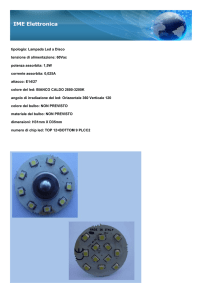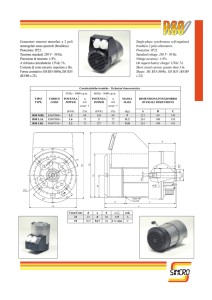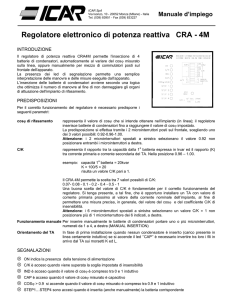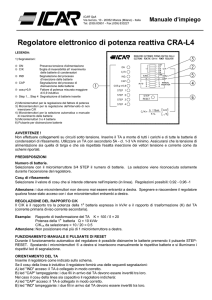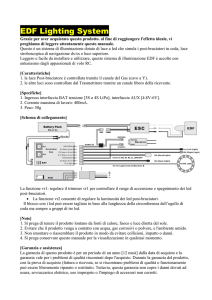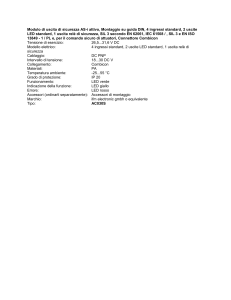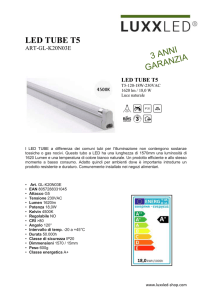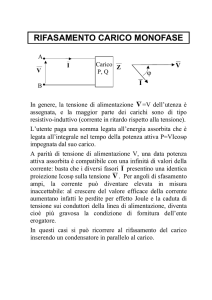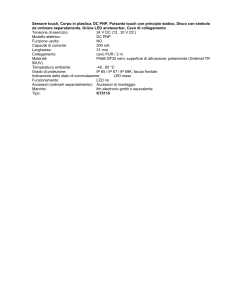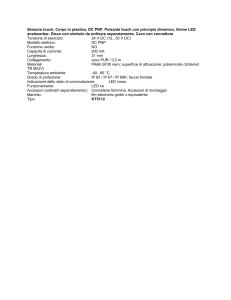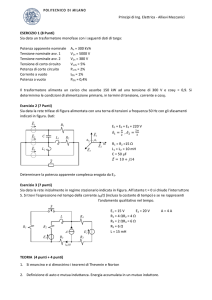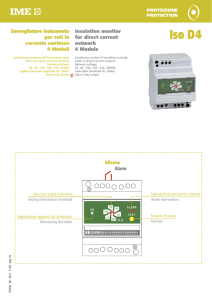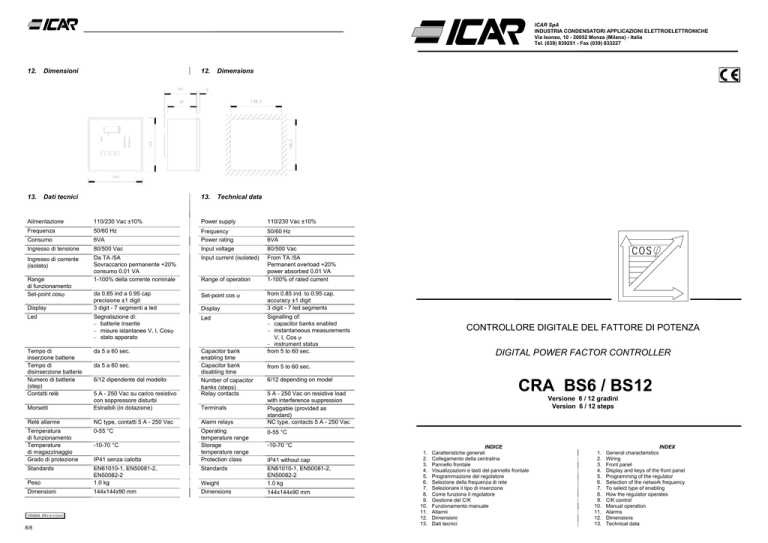
ICAR SpA
INDUSTRIA CONDENSATORI APPLICAZIONI ELETTROELETTRONICHE
Via Isonzo, 10 - 20052 Monza (Milano) - Italia
Tel. (039) 839251 - Fax (039) 833227
12.
Dimensioni
12.
Dimensions
13.
Dati tecnici
13.
Technical data
Alimentazione
110/230 Vac ±10%
Power supply
110/230 Vac ±10%
Frequenza
50/60 Hz
Consumo
6VA
Frequency
Power rating
50/60 Hz
6VA
Ingresso di tensione
80/500 Vac
Input voltage
80/500 Vac
Ingresso di corrente
(isolato)
Da TA /5A
Sovraccarico permanente +20%
consumo 0.01 VA
1-100% della corrente nominale
Input current (isolated)
From TA /5A
Permanent overload +20%
power absorbed 0.01 VA
1-100% of rated current
Range
di funzionamento
Set-point cosϕ
Display
Led
Tempo di
inserzione batterie
Tempo di
disinserzione batterie
Numero di batterie
(step)
Contatti relè
Morsetti
da 0.85 ind a 0.95 cap
precisione ±1 digit
3 digit - 7 segmenti a led
Range of operation
Set-point cos ϕ
Display
Segnalazione di:
− batterie inserite
− misure istantanee V, I, Cosϕ
− stato apparato
Led
da 5 a 60 sec.
Capacitor bank
enabling time
Capacitor bank
disabling time
Number of capacitor
banks (steps)
Relay contacts
da 5 a 60 sec.
6/12 dipendente dal modello
5 A - 250 Vac su carico resistivo
con soppressore disturbi
Estraibili (in dotazione)
Terminals
Relè allarme
NC type, contatti 5 A - 250 Vac
Alarm relays
Temperatura
di funzionamento
Temperature
di magazzinaggio
Grado di protezione
0-55 °C
Operating
temperature range
Storage
temperature range
Protection class
Standards
Peso
EN61010-1, EN50081-2,
EN50082-2
1.0 kg
Dimensioni
144x144x90 mm
CRABS6 REV.A 01/02/00
8/8
-10-70 °C
IP41 senza calotta
Standards
Weight
Dimensions
from 0.85 ind. to 0.95 cap.
accuracy ±1 digit
3 digit - 7 led segments
Signalling of:
− capacitor banks enabled
− instantaneous measurements
V, I, Cos ϕ
− instrument status
from 5 to 60 sec.
CONTROLLORE DIGITALE DEL FATTORE DI POTENZA
DIGITAL POWER FACTOR CONTROLLER
from 5 to 60 sec.
6/12 depending on model
CRA BS6 / BS12
5 A - 250 Vac on resistive load
with interference suppression
Pluggable (provided as
standard)
NC type, contacts 5 A - 250 Vac
Versione 6 / 12 gradini
Version 6 / 12 steps
0-55 °C
-10-70 °C
IP41 without cap
EN61010-1, EN50081-2,
EN50082-2
1.0 kg
144x144x90 mm
1.
2.
3.
4.
5.
6.
7.
8.
9.
10.
11.
12.
13.
INDICE
Caratteristiche generali
Collegamento della centralina
Pannello frontale
Visualizzazioni e tasti del pannello frontale
Programmazione del regolatore
Selezione della frequenza di rete
Selezionare il tipo di inserzione
Come funziona il regolatore
Gestione del C/K
Funzionamento manuale
Allarmi
Dimensioni
Dati tecnici
1.
2.
3.
4.
5.
6.
7.
8.
9.
10.
11.
12.
13.
INDEX
General characteristics
Wiring
Front panel
Display and keys of the front panel
Programming of the regulator
Selection of the network frequency
To select type of enabling
How the regulator operates
C/K control
Manual operation
Alarms
Dimensions
Technical data
1. Caratteristiche generali
1. General characteristics
9. Gestione del C/K
9. C/K control
Il regolatore BS6-12 è un dispositivo a microprocessore per la
compensazione automatica del fattore di potenza (cosϕ)
d’impianto, con possibilità di regolazione fino a 12 gradini.
Regulator BS6-12 is microprocessor-based instrument for
automatic power factor (cosϕ) compensation in systems, with
range of correction of up to 12 steps.
L’apparato è stato progettato per assicurare elevata precisione
nella regolazione del fattore di potenza ed un’eccellente
utilizzazione dei banchi di condensatori e degli organi
d’attuazione, anche in presenza di condizioni di rumore e di
forme d'onda di corrente molto distorte.
The instrument has been designed to ensure high accuracy in
power factor correction as well as optimum use of capacitor
banks and contactors, even under conditions of noise and highly
distorted current waveforms.
La regolazione automatica della potenza reattiva è effettuata solo
se la corrente di linea misurata supera il valore equivalente di C/K
calcolato dal regolatore (corrente reattiva corrispondente al primo
banco di condensatori): in tal caso il led C/K è acceso. Se la
corrente di linea è inferiore al valore di C/K corrispondente, il
regolatore (per evitare pendolazioni) mantiene inalterata la
configurazione dei banchi di condensatori: in tal caso led C/K è
lampeggiante.
Automatic reactive power correction is performed only when the
measured line current exceeds the equivalent C/K value
calculated by the regulator (reactive current corresponding to the
first capacitor bank): in such case the led C/K LED is lit up.
When the line current is less than the corresponding C/K value,
the regulator (in order to avoid hunting) does not alter the
capacitor bank configuration: in such case the led C/K LED
starts flashing.
In caso di corrente di linea molto bassa (inferiore al 5% della
corrente equivalente C/K), il regolatore distacca tutti i banchi di
condensatori: in tal caso led C/K è spento.
If the line current is very low (below 5% of the equivalent C/K
current), the regulator disconnects all capacitor banks: in such
case the led C/K LED is off.
10. Funzionamento manuale
10. Manual operation
E' possibile operare manualmente sui banchi di condensatori:
It is possible to control the capacitor banks in manual mode:
premendo insieme i tasti + e -.
by pressing the + and - buttons together.
II regolatore mostra sul display il banco da controllare
manualmente, partendo dal primo:
The regulator shows the capacitor bank to be controlled manually
starting off from the first:
BO1
BO1
Through four buttons it is possible to show different
measurements on the display, program the instrument, operate
manually on the capacitor banks or cancel the alarms.
Attraverso il tasto MODE è possibile selezionare quale banco
azionare manualmente, mentre utilizzando i tasti + e - è possibile
inserire o disinserire rispettivamente il banco selezionato.
The regulator is supplied with various protective features,
through continuous monitoring of the following quantities:
Premendo due volte il tasto + l'inserzione manuale diventa
permanentemente memorizzata (anche in caso di spegnimento):
in tal caso il led corrispondente lampeggia. Utilizzare il tasto - per
disinserire il banco.
The MODE button can be used to select which capacitor bank to
actuate in manual mode while with the + and - buttons the
selected capacitor bank can be connected or disconnected
respectively.
II regolatore può essere installato su reti trifase 50/60Hz con
inserzione in quadratura o diritta, attraverso TA (trasformatori
amperometrici) per l'acquisizione della corrente di linea. E'
anche possibile l'installazione su reti monofase. Tutti i circuiti
d’ingresso sono tra loro isolati.
II pannello frontale è dotato di un display a 3 digit - 7 segmenti
per la visualizzazione dei valori istantanei del cosfi, della
tensione e della corrente di linea: ciò consente di evitare
l'installazione d’altri misuratori da pannello (voltmetri,
amperometri) sul quadro di rifasamento.
Un completo gruppo di led sul pannello frontale fornisce
indicazioni sullo stato dell'apparato, sui banchi di condensatori
inseriti, sul quadrante di funzionamento (induttivo/capacitivo) e
sull'attivazione della regolazione automatica (C/K).
Attraverso quattro tasti è possibile selezionare sul display la
visualizzazione delle differenti misure, programmare l'apparato,
operare manualmente sui banchi di condensatori e cancellare gli
allarmi.
II regolatore è fornito di diverse protezioni, attraverso il
monitoraggio continuo delle seguenti grandezze:
−
Tensione di linea: un allarme è generato qualora la
tensione sui condensatori superi il valore programmato per
un tempo superiore a 30 minuti;
−
Corrente di linea: un allarme è generato qualora la corrente
di linea superi +20% del valore nominale;
−
Cosϕ: un allarme è generato se il cosϕ non è
adeguatamente compensato nel range programmato entro
15 minuti.
Gli allarmi sono automaticamente rimossi quando la condizione
che li ha generati scompare: se pero' più di 3 allarmi si verificano
entro 1 ora, viene richiesto un ripristino manuale dell'allarme, per
segnalare una possibile condizione anomala nel sistema di
rifasamento.
TM
La tecnologia TPDS (True Phase Detection System) applicata
all’elaborazione dei segnali di tensione e corrente consente al
regolatore di operare correttamente e con precisione anche con
forme d'onda di corrente fortemente distorte: utilizzando una
sofisticata elaborazione digitale dei segnali, l'apparato è in grado
di estrarre tra tutte le componenti del segnale le componenti
fondamentali di tensione e corrente, al fine di valutare lo
sfasamento relativo e quindi di regolare correttamente la potenza
reattiva.
The regulator can be installed in three phase power supplies
50/60Hz, and switched in quadrature or direct, through a CT's
(current transformers) for acquisition of the line current. The
regulator can also be installed in single phase power supplies.
All input circuits are isolated from each other.
The front panel is provided with a 3 digit - 7 segment display for
showing the instantaneous values of cosϕ, voltage and line
current: this avoids need to install other panel meters
(voltmeters, ammeters) on the power factor correction panel.
A full set of LED's on the front panel supplies information
regarding the instrument status, the capacitor banks enabled,
the operating quadrant (inductive/ /capacitive) and activation of
automatic correction (C/K).
−
Line voltage: an alarm is generated when the voltage
across the capacitors exceeds the programmed value for a
time greater than 30 minutes;
−
Line current: an alarm is generated when the line current
exceeds the rated current by +20%;
−
cosϕ: an alarm is generated if the cosϕ is not adequately
compensated in the programmed range within 15 minutes.
The alarms are eliminated automatically when the condition
generating them disappears: however, if more than 3 alarms
occur within 1 hour, manual resetting of the alarm is requested in
order to signal a possible fault condition in the power factor
correction system.
TM
The TPDS (True Phase Detection System) technology used in
processing the voltage and current signals allows the regulator
to operate correctly and accurately even with highly distorted
current waveforms: by using sophisticated digital processing of
the signals, the instrument is able to extract the fundamental
voltage and current components from all signal components in
order to assess the relative phase shift and therefore to correct
the reactive power.
11. Allarmi
In casa di allarme, il regolatore si comporta come segue:
−
allarme di sovratensione (la tensione supera il valore
massimo impostato per un tempo superiore a 30 minuti):
l'apparato sconnette tutti i banchi di condensatori (inclusi
quelli inseriti manualmente), apre il relè di allarme, accende il
led di allarme e fa lampeggiare iI led di tensione;
−
allarme di sovracorrente (la corrente di linea (al secondario
del TA) supera 6A per oltre 3 secondi): l'apparato apre il relè
di allarme, accende il led di allarme e fa lampeggiare il led di
corrente;
−
allarme di cosϕ non regolato (la compensazione del cosϕ
entro il range programmato non è stata ottenuta entro 15
minuti) l'apparato apre il relè di allarme, accende il led di
allarme e fa lampeggiare il led di cosϕ, ma continua a
operare in modo normale.
Quando la condizione di
allarme termina, il regolatore
automaticamente esce dallo stato di allarme: tuttavia, se più di 3
allarmi si verificano entro un'ora, l'apparato richiede un ripristino
(reset) manuale dell'allarme, per segnalare una condizione
anomala derivante da un possibile guasto nell'impianto.
Per ripristinare l'allarme, premere per almeno 3 secondi il tasto
RESET.
2/8
When the + button is pressed twice, the manual enabling
becomes permanently memorized (even when the instrument is
switched off): in such case the corresonding LED starts flashing.
Use the - button to disable the capacitor bank.
11. Alarms
In the event of alarm, the regulator behaves as follows:
−
overvoltage alarm (voltage exceeds preset max. value for
a time exceeding 30 minutes: the instrument disconnects all
capacitor banks (included those connected in manual
mode), then it opens the alarm relay, thus causing the alarm
LED to lit up and the voltage LED to start flashing;
−
overcurrent alarm (the line current (on transformer
secondary) exceeds 6A for over 3 seconds): the regulator
opens the alarm relay, thus causing the alarm LED to lit up
and the current LED to start flashing;
−
cosϕ not corrected alarm (compensation of cos Φ within
the programmed range has not been obtained within 15
minutes); the regulator opens the alarm relay, thus causing
the alarm LED to lit up and the cosϕ LED to start flashing
but it continues to operate in normal mode.
When the alarm condition is ended, the regulator automatically
quits the alarm status: however, if more than 3 alarms occur
within one hour, the instrument requests a manual reset of the
alarm to signal a fault condition possibly caused by a failure in the
system.
To reset the alarm, press the RESET button for at least 3
seconds.
7/8
8. Come funziona il regolatore
8. How the regulator operates
II regolatore calcola in vero valore efficace (tme RMS), la misura
di tensione e corrente e ne ricava lo sfasamento relativo tra le loro
componenti fondamentali. Tale misura è ottenuta dai valori di
potenza attiva e reattiva mediati su 5 secondi, per garantire
accuratezza e stabilità anche con forme d'onda distorte.
The regulator calculates the RMS value of the voltage and
current, then derives the relative phase shift between their
fundamental components. Such measurement is obtained from
the active and reactive power values averaged over 5 seconds in
order to ensure accuracy and stability even with distorted
waveforms.
Attraverso il tasto MODE è possibile visualizzare sul display i
valori istantanei del cosϕ, della tensione e corrente di linea. II led
corrispondente a fianco del display indica la misura visualizzata.
Premendo insieme i tasti RESET e +, vengono visualizzate
ciclicamente sul display tutte le misure, ad intervalli di 3 sec. .
Premendo un qualsiasi tasto, la scansione ciclica viene sospesa.
Se il cosϕ misurato è capacitivo, il led CAP è acceso.
Se non c'è segnale di tensione o corrente, il cosϕ è indefinito.
In tal caso, il display mostra tale indicazione: - - Se il cosϕ misurato è inferiore al set-point impostato, il regolatore
inserirà dopo il tempo di ritardo programmato il successivo banco
di condensatori (se disponibile). Se il cosϕ misurato è superiore al
valore di soglia superiore (vedi oltre), il regolatore disconnetterà il
successivo banco di condensatori (se disponibile). Se iI cosϕ
misurato permane entro il set-point inferiore e superiore, il
regolatore mantiene inalterata la configurazione dei banchi di
condensatori.
La soglia superiore di cosϕ è fissata a 5 punti sopra il valore di
set-point inferiore programmato, secondo la seguente tabella:
With the MODE button it is possible to show the instantaneous
values of cosϕ, voltage and line current on the display. The
corresponding LED alongside the display indicates the
measurement displayed. When RESET and + are pressed
together, all measurements appear cyclically on the display at
intervals of 3 sec. The cyclic scanning can be interrupted by
pressing any of the buttons.
When the cosϕ being measured is capacitive, the CAP LED is lit
up.
If there is no voltage or current signals, the cosϕ is not defined.
2. Collegamento della centralina
(Inserzione trifase)
2. Wiring
(Three-phase insertion)
IMPORTANTE
1. Per inserzione trifase, l’ingresso voltmetrico deve essere
connesso tra due fasi; il TA di linea deve essere inserito sulla
rimanente fase.
2. La polarità dell’ingresso amperometrico è ininfluente.
IMPORTANT
1. For three-phase insertion, the voltage input be connected
phase to phase: the current transformer must be inserted
on the remained phase.
2. The polarity of the current/voltage input is different.
ATTENZIONE: TOGLIERE SEMPRE TENSIONE
QUANDO SI OPERA SUI MORSETTI
WARNING: DISCONNECT THE LINE AND THE SUPPLY
WHEN OPERATING ON TERMINALS
Questo apparecchio deve essere installato da persone
qualificate,
nel
rispetto
delle
vigenti
normative
impiantistiche, allo scopo di evitare danni a persone o cose.
Il carico massimo comandabile dai relè di uscita
dell’apparato è di 5A ciascuno; in caso di controllo di carichi
con assorbimento superiore a 5A, è necessario utilizzare
contattori di potenza pilotati dai relè di uscita dell’apparato.
This equipment is to be installed by trained personnel,
complying to current standards, to avoid damages or
health and safety hazards.
The maximum controllable load by the device output
relay is 5A each; for control loads with absorption
higher than 5A it is necessary use power cantactor
controlled by device output relay.
In such case, the display shows the indication: - - 1
If the cosϕ being measured is less than the preset set-point, after
a programmed timed delay the regulator will connect the next
capacitor bank (if available). If the cosϕ being measured exceeds
the upper threshold (see later on), the regulator will disconnect
the next capacitor bank (if available). If the cosϕ being measured
remains within the lower set-point and upper threshold, the
regulator makes no alteration to the capacitor bank configuration.
0.88 ind.
0.93 ind.
0.90 ind.
0.95 ind.
0.96 ind.
0.99 cap.
0.98 ind.
0.97 cap.
0.99 ind.
0.96 cap.
1.00
0.95 cap.
0.98 cap.
0.93 cap.
1
X
X
X
X
X
X
Sequenza di inserzione
Enabling sequence
2
3
11
X
X
X
X
X
X
X
X
X
X
X
12
X
1
X
6
7
8
9
10
11 12 13
CURRENT
INPUT
6A MAX
2
VOLTAGE
INPUT
500VAC MAX
3 4
5
AUXILIARY
SUPPLY
115VAC
0
6 7
8
ALARM
230VAC
9 10 11 12
6VA MAX
M2
1 2 3
NO NC COM
M3
L1
L2
to Loads
L3
3. Pannello frontale
3. Front panel
cDisplay a led per indicazione cosfi, tensione
c LED display for indicating cosϕ, voltage
e corrente
The connect/disconnect strategy always involves the first
capacitor bank enabled/disabled starting from the bottom
according to the following scheme:
Sequenza di disinserzione
Disabling sequence
2
3
11
X
X
X
X
X
X
X
X
X
X
5
CAPACITOR BANKS
dLed
La strategia di inserzione/disinserzione manovra sempre il primo
banco disinserito/inserito partendo dal basso, secondo il seguente
schema:
4
B1 B2 B3 B4 B5 B6 B7 B8 B9 B10 B11 B12 COM
1
Soglia Cosϕ superiore corrispondente
Corresponding upper cosϕ threshold
3
M1
The upper cosϕ threshold is fixed at 5 points above the
programmed lower set-point, according to the following table:
Set-point Cosϕ inferiore
Lower cosϕ set-point
2
di stato: cosϕ cap/ind, C/K attivo,
allarme
eTasto reset manuale allarmi
fTasto incremento parametro di
setup/inserzione manuale di un banco di
condensatori
12
X
X
X
X
X
X
gTasto decremento parametro di setup /
disinserzlone manuale di un banco di
condensatori
hTasto selezione misure o parametro di
setup
iLed indicazione batterie inserite
jLed indicatore misura o parametro di setup
and current
d Status LED's:
cap/ind cosϕ, C/K enabled,
0.95
alarm
x 1000
e Button, manual alarm reset
f Button, to increase setup/manual input
COS
V
I
SETUP
STEP
CAP
C/K
1
2
7
8
ALARM
3
4
9
10
5
11
6
12
parameter for a capacitor bank
g Button, to decrease manual disabling/
setup parameter for a capacitor bank
h Button, selection of measurements or
setup parameter
i Led indicating capacitor bank enabled
j Led indicating currently displayed
measurement or setup parameter
correntemente visualizzato
6/8
3/8
4. Visualizzazioni e tasti del pannello frontale
4. Display and keys of the front panel
LED MISURA
MEASUREMENT LED’s
⊗ cosϕ, V, I
Indica la misura correntemente visualizzata (cosϕ,
tensione, corrente) – notare che il setup è spento-
Indicates currently displayed measurement cosϕ, voltage,
current) – setup is off.
⊗ x 1000
Moltiplicatore x 1000 del valore misurato.
Moltiplier by 1000 of the measured value.
LED DI STATO
STATUS LED’s
⊗ CAP
Il cosϕ visualizzato è capacitivo.
The displayed cosϕ is capacitive.
⊗ C/K
ON: la corrente di linea ha un valore sopra il minimo che
consente la regolazione automatica del cosϕ.
ON: the line current is higher than the minimum value that
enables the automatic regolation of cosϕ.
BLINK: la corrente di linea è inferiore al minimo valore che BLINK:the line current is lower than the minimum value
that enables the automatic regolation of cosϕ. Capacitor
consente la regolazione automatica del cosϕ. La
configurazione dei banchi di condensatori viene mantenuta banks configuration don’t change.
inalterata.
OFF: the line current is lower than the minimum misurable
value: capacitor banks are disconnected.
OFF: la corrente di linea è inferiore al minimo valore
misurabile: i banchi di condensatori sono disinseriti.
⊗ ALARM
RESET
+
Lampeggia insieme al led corrispondente di misura in
allarme, per indicare una condizione di allarme raggiunta
da una o più misure.
TASTI
KEYS
(un tasto solo premuto)
(one key pressed)
MODE
To program the regulator, press the MODE and + both together
for a time greater than 5 sec. The regulator disconnects the
enabled capacitor banks in sequence and the setup LED lights
up. The following parameters can be programmed:
Level 1 parameters (setup LED lit up):
−
cosϕ set-point (from 0.85 ind. to 0.95 cap.): default 0.95
−
primary transformer current (from 5 to 10000A): default 500
A
−
capacitance of the first (the least) capacitor bank
expressed in kVAr (from 1 to 999kVAr), referred to rated
voltage: default 5kVAr.
Level 2 parameters (setup LED flashing):
−
max. operating voltage of the capacitors (from 80 to 540V):
default 418V
−
delay between two consecutive enabling operations of
capacitor banks (when cosϕ is less than the lower setpoint) (from 5 to 60 sec.): default 10 sec.
−
delay between two consecutive disabling operations of
capacitor banks (when cosϕ exceeds the upper threshold)
(from 5 to 60 sec.): default 5 sec.
Through the MODE, + and - buttons it is possible to select each
parameter and change its value. The parameter which is being
changed is indicated by the lighting up of the corresponding LED
(flashing for the second level parameters). See legend at top left
on the panel for indication of the parameter under adjustment.
After 10 seconds from pressing the last button, the regulator
quits the setup mode automatically; the setup LED goes out and
the instrument returns to normal mode (automatic cosϕ
correction).
− In modo normale, forza un reset allarme (se tenuto
premuto per almeno 3 sec.).
− In standard mode, it forces the alarm reset (when
pressed for at least 3 seconds).
− In modo setup, forza il parametro in modifica al suo
valore di default.
− In setup mode, it forces the default value of the
parameter being programmed.
− All’accensione, forza al valore di default tutti i parametri
di setup.
− When switching on, it forces the default value of all the
setup parameters.
6. Selezione della frequenza di rete
6. Selection of the network frequency
− In modo manuale, inserisce il banco di condensatore
selezionato. Se premuto due volte, l’inserzione è
permanentemente memorizzata in memoria non volatile
per le successive riaccensioni (led lampeggiante).
− In manual mode, it inserts the selected capacitor bank. If
pressed two times, the insertion is memorized for the
next restarts (flashing led).
All’accensione, l'apparato mostra la frequenza di rete impostata:
F 50: 50Hz (default)
F 60: 60Hz
E’ possibile selezionare la frequenza di rete tra 50 e 60 Hz. Per
programmare la frequenza di rete, tenere premuti durante
l’accensione i tasti RESET e -: il regolatore alternativamente
seleziona 50 o 60Hz. Il valore impostato viene mantenuto
permanentemente, finchè non nuovamente modificato.
When switching on, the instrument shows the network frequency
programmed:
F 50: 50Hz (default)
F 60: 60Hz
It is possible to select the network frequency between 50 and 60
Hz. To program the network frequency, hold down the RESET
and – buttons when switching on the regulator selects
alternatively 50 or 60Hz. The preset value will be held
permanently until changed again.
− In modo setup, incrementa il valore del parametro in
modifica.
-
Flashing together with the dimension under alarm to
indicate that an alarm condition has been reached by one
or more of the dimensions.
Per programmare il regolatore, premere i tasti MODE e +
insieme per un tempo superiore a 5 sec. II regolatore
disconnette in sequenza i banchi di condensatori inseriti ed
accende il led di setup. I parametri programmabili sono i
seguenti:
Parametri di livello 1 (led di setup acceso):
−
set-point del cosϕ (da 0.85 ind. a 0.95 cap.): default 0.95;
−
corrente primaria del TA (da 5 a 10000A): default 500 A;
−
capacità della prima (la minore) batteria espressa in kVAr
(da 1 a 999kVAr), riferita alla tensione nominale: default
5kVAr.
Parametri di livello 2 (led di setup lampeggiante):
−
massima tensione di funzionamento dei condensatori (da
80 a 540V): default 418V;
−
ritardo tra due inserzioni consecutive di banchi di
condensatori (quando il cosϕ è inferiore al set-point
inferiore) (da 5 a 60 sec.): default 10 sec.;
−
ritardo tra due disinserzioni consecutive di banchi di
condensatori (quando il cosϕ è oltre la soglia superiore)
(da 5 a 60 sec.): default 5 sec.
Attraverso i tasti MODE, +, - è possibile selezionare e
modificare il valore di ogni parametro. II parametro
correntemente in modifica è indicato dal corrispondente led
acceso (lampeggiante per i parametri di secondo livello).
Guardare la legenda in alto a sinistra sul pannello per ottenere
l'indicazione del parametro in modifica.
Dopo 10 secondi dalla pressione dell'ultimo tasto,
automaticamente il regolatore esce dal modo setup, spegne il
led di setup e torna in modo normale (regolazione automatica
del cosϕ).
− In setup mode, it increases the value of the parameter
being programmed.
− In modo manuale, disconnette il banco di condensatore
selezionato.
− In manual mode, it disconnects the selected capacitor
bank.
− In modo setup, decrementa il valore del parametro in
modifica.
− In setup mode, it decreases the value of the parameter
being programmed.
− In modo normale, seleziona la misura da visualizzare.
− In standard mode, it selects the displayed measure.
− In modo manuale, seleziona il banco da azionare
manualmente.
− In manual mode, it selects the bank to be connected
manually.
TASTI SPECIALI
SPECIAL KEYS
(due tasti contemporaneamente)
(two keys to be pressed together)
MODE con/with +
Se premuto per 5 sec. Attiva il modo setup per la
programmazione dei parametri di funzionamento.
When pressed for 5 seconds, they enable setup mode for
the programming of the operation parameters.
RESET con/with -
Se premuto in modo normale, stabilisce la misura
correntemente visualizzata come misura di default
visualizzata all’accensione (default cosϕ).
When pressed in standard mode, they estabilish the
default value displayed when switching on of the displayed
measure.
RESET con/with +
Se premuto in modo normale, inizia una visualizzazione
ciclica di tutte le misure ogni 3 sec.
When pressed in standard mode, they enable cyclic
scanning every 3 seconds of all the measurements.
+ con/with -
Entra in modo manuale, per il comando diretto dei banchi
di condensatori.
Go in manual mode, for the direct command of the
capacitor bank.
E’ assolutamente indispensabile impostare la
frequenza di rete uguale a quella effettiva della rete su
cui è installato il regolatore, altrimenti il funzionamento
non è corretto.
7. Selezionare il tipo di inserzione
All’accensione, l’apparato mostra il tipo di inserzione
selezionata:
3 PH: inserzione trifase in quadratura (default)
1 PH: inserzione diritta (monofase)
Nell’inserzione in quadratura la tensione viene acquisita da 2 fasi
mentre la corrente viene acquisita dall’altra fase. E’ possibile
selezionare il tipo di inserzione: per fare ciò tenere premuti
durante l’accensione i tasti RESET e +: il regolatore
alternativamente seleziona inserzione in quadratura o diritta.
II valore impostato viene mantenuto permanentemente, finché
non nuovamente modificato.
E’ assolutamente indispensabile impostare il tipo di
inserzione uguale a quella effettivamente utilizzata,
altrimenti il funzionamento non è corretto.
It is absulutely essential to preset the same type of
network frequency as the one effective of the network in
which the regulator is installed, otherwise operation
would not be correct.
7. To select type of enabling
When switching on, the instrument shows the type of enabling
selected:
3 PH: three phase enabling in quadrature (default)
1 PH: direct enabling (single phase)
When enabling in quadrature, the voltage is acquired by 2 phases
while the current is acquired by the other phase. The type of
enabling can be selected; to do so, hold down the RESET and +
buttons when switching on: the regulator selects enabling in
quadrature or direct.
The preset value will be held permanently until changed again.
It is absolutely essential to preset the same type of
enabling as the one effectively used otherwise operation
would not be correct.
5/8
4/8
5. Programmazione del regolatore
5. Programming of the regulator

